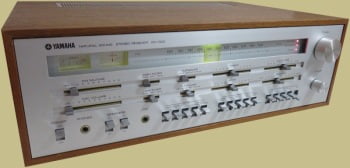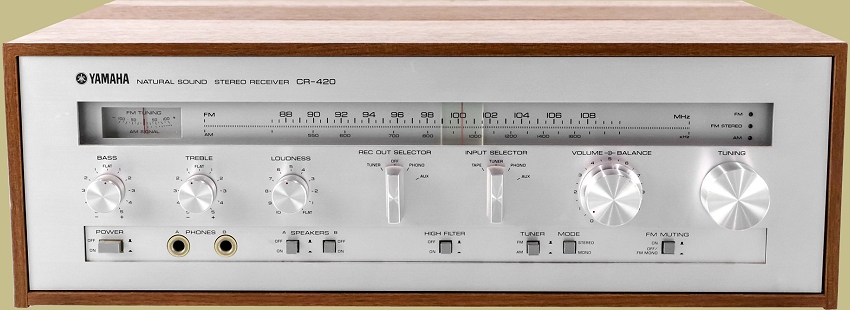
The Yamaha CR-420 was offered from 1977 through about 1980 and retailed for $290. It was part of Yamaha’s Natural Sound line of audio equipment. It was marketed as a low-powered, affordable integrated receiver that offered the control features and flexibility commonly found in more powerful, expensive models. The CR-420’s styling is classic Yamaha with a brushed aluminum silver face and dial scale, sleek cabinet, and large selector switches.
The Natural Sound concept is to reproduce natural, unbiased sound that is very clean and true to the original source. Many feel this is the case with the Yamaha receivers. Others think this is just marketing hype. Either way the Yamaha CR line of receivers does produce a very clean sound.

Controls
The CR-420 has a narrow front dial display with linear frequency scales for FM and AM radio bands. The FM band is marked with station frequencies every 0.5 MHz. To the right of the frequency scales are indicator lights that show when you are tuned to an AM station, an FM station, or a stereo FM station. On the left side is a single meter that shows the signal strength when tuned to an AM station, or shows when you are centered on the channel when listening to FM.
In the center section of the front panel there are typical bass and treble control knobs (adjustable in steps), a separate continuously adjustable loudness control, two selector knobs to choose input sources and output sources separately, dual concentric knobs for volume and balance, and a tuning knob coupled to a flywheel.

Along the bottom of the front panel are controls including a power button, A/B speaker selector, a high-cut filter switch, a button to select AM or FM bands, a mono/stereo mode switch, and an FM muting on/off switch which restricts reception to mono-only when muted. There are also two headphone jacks.
Loudness
The loudness control on the Yamaha CR-420 is a bit unique. It is a separate, continuously variable loudness control apart from the main volume knob. The loudness knob is positioned before the tone control circuitry in the signal chain. At max clockwise position, it provides no loudness boost. In use, the listener sets the volume for a natural sound level, then turns the loudness knob counterclockwise. This attenuates the overall level while progressively emphasizing bass and treble to compensate for the Fletcher-Munson effect on human hearing at lower volumes. Unlike loudness switches that work unpredictably, this layout allows effective loudness compensation regardless of program level or speaker efficiency.

Tuning
The FM tuner in the CR-420 is excellent. More technically, it uses a junction field effect transistor (JFET) for RF amplification in the FM front end, along with a three-section variable capacitor. The intermediate frequency (IF) stage has a two-element ceramic filter and a two-stage direct-coupled amplifier. The ceramic filter and current limiter make up a three-stage differential amplifier. FM demodulation uses a wide-range modified balanced detector. This feeds into a negative feedback phase-locked loop stereo decoder circuit.
The AM tuner section has an untuned RF amplifier, a self-oscillating converter, a ceramic filter for the IF stage, and a peak detector circuit. Some reviewers declared AM reception to be adequate but not exceptional.
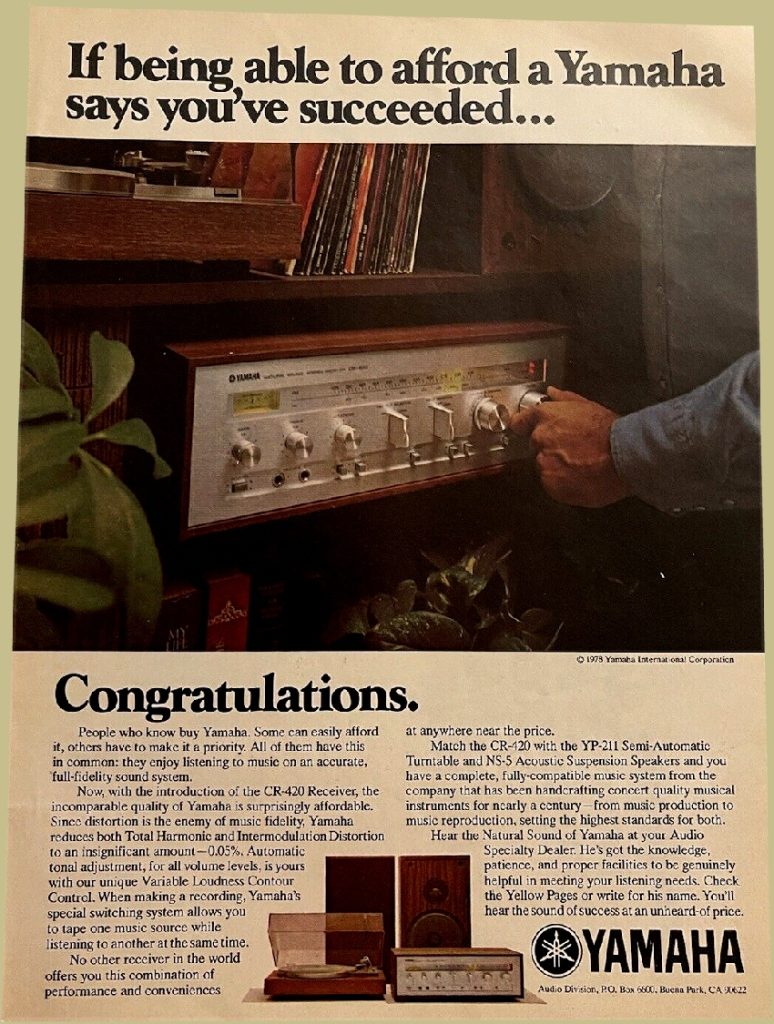
Specifications
- Tuning range: FM, MW
- Power output: 22 watts per channel into 8Ω (stereo)
- Frequency response: 20Hz to 20kHz
- Total harmonic distortion: 0.05%
- Damping factor: 40
- Input sensitivity: 2mV (MM), 120mV (line)
- Signal to noise ratio: 91dB (MM), 97dB (line)
- Output: 120mV (line)
- Speaker load impedance: 4Ω (minimum)
- Semiconductors: 2 x IC, 1 x FET, 53 x transistors, 25 x diodes, 5 x zener diodes, 3 x LED
- Dimensions: 451 x 161 x 324mm
- Weight: 9kg
- Dimensions: 17 3/4 in. (45 cm) W x 6 1/3in. (16 cm) H x 12 3/4 in. (32.4 cm) D.
- Weight: 19 lbs. (8.6 kg)
There is also a black version of the CR-420. It not only has a black faceplate but a black cabinet as well.
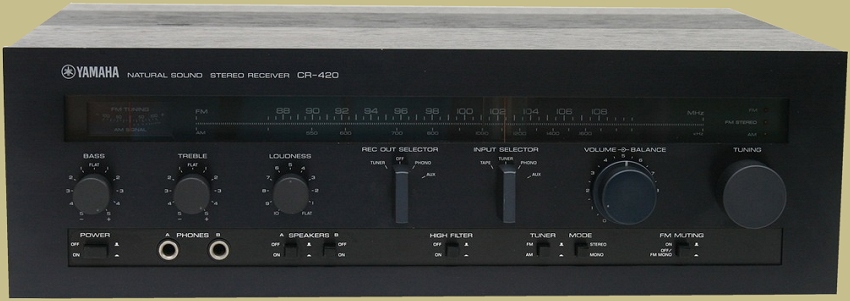
The Yamaha CR-66II was apparently a Canadian version of the CR-420 but with a black faceplate and rosewood cabinet.
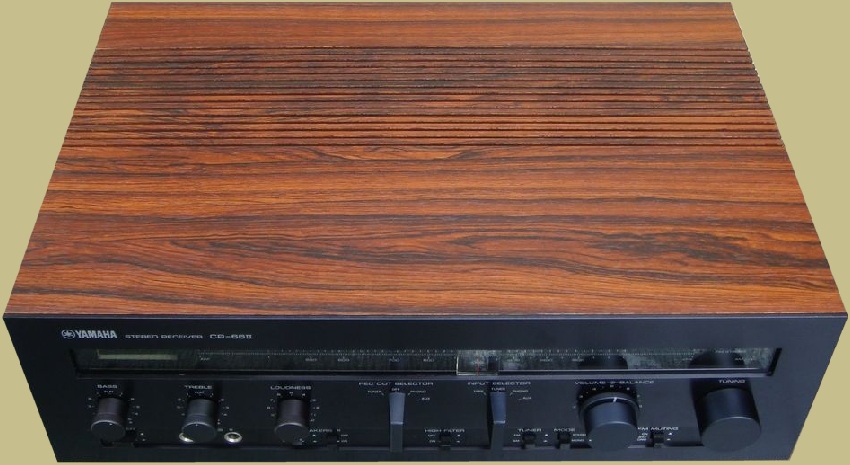
Yamaha CR-66 II = Yamaha CR-420 except for the black faceplate and rosewood cabinet.
Yamaha CR-66 = Yamaha CR-450 except for the black faceplate and rosewood cabinet.
Amplifier
The CR-420 is rated at 22 watts per channel with total harmonic distortion at 0.05%. That’s an impressive distortion level for a ‘budget’ receiver.
Audio magazine tested the amplifier back in 1978 and had this to say about it’s power output:
The power amplifier section of the Yamaha CR-420 delivered nearly 34 watts of power per channel into 8 ohm loads at a test frequency of 1 kHz. At 20 Hz, the rated harmonic distortion figure of 0.05 per cent was reached when the amp was putting out 31 watts per channel, while at the high end, even greater power was available before reaching rated THD.
Based upon FTC rules, the amp section could have been rated at 31 watts per channel instead of the 22 watts per channel which Yamaha publishes. At the published rated output, THD for 1 kHz measured only 0.008 per cent, while IM distortion was almost as low, at 0.009 per cent.
Inside the CR-420 is clean and uncluttered which makes for a fairly easy to service receiver. Construction is all discrete components as well, no unobtainable power packs. Parts are readily available for the CR-420 as well. To see what parts are currently available on eBay check HERE.
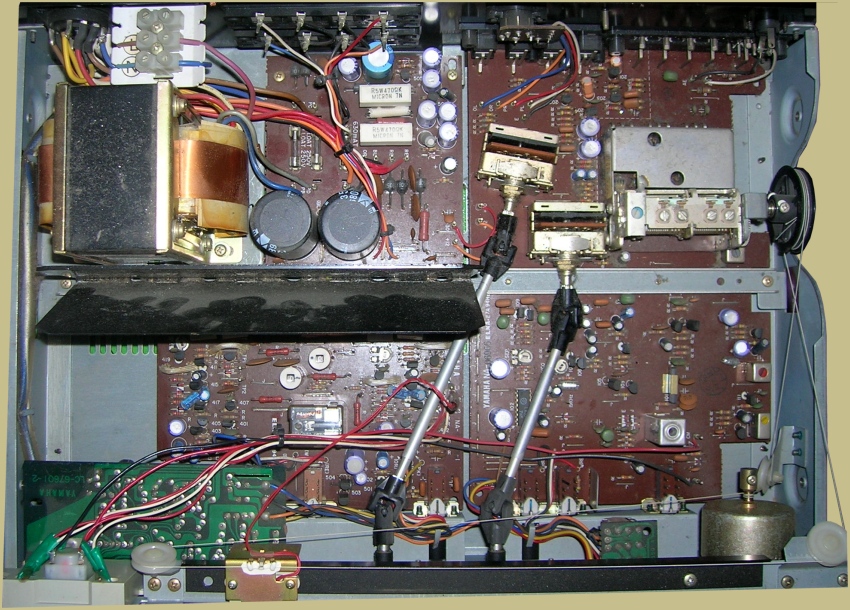
Reviews
Here’s what some owner’s of the Yamaha CR-420 have said about it:
Phenomenal receiver. Quality build and nice sounding.
Classic. Low power. Clean sound…and good looking.
This little receiver is a gem in its class.
Rear Panel
The CR-420’s rear panel contains two sets of spring-clamp speaker terminals, an AC outlet pair (one switched), input jacks for phono, auxiliary, and tape signals, tape recording outputs, and antenna connectors for 75/300 ohm FM antennas and AM radio. A factory-installed jumper bar bridges the AM and 300 ohm FM terminals, allowing a single FM antenna to serve for both bands. For improved AM reception, this bar can be removed and a dedicated AM antenna connected.

Audio magazine said of the Yamaha CR-420:
If you examined the features and control panel of this receiver, you would never guess either its price or its power output capability. For the audio enthusiast who needs a lower powered receiver with as many control features as possible, the Yamaha CR-420 is a worthy contender.
Their opinion still stands today. If you’re looking for a lower powered receiver with a decent array of features for a turntable or streaming device then the CR-420 is a great choice. The other nice thing about them is that they aren’t absurdly priced like other high end receivers. They are well built, stylish, perform well and are easily repaired. You can’t really beat that combination.
